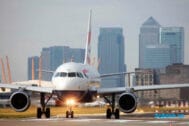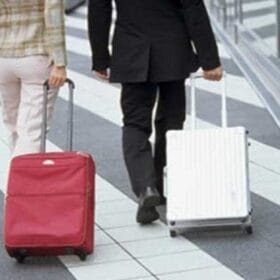Websosanh – Airplanes are becoming a popular means of transportation, especially for traveling long distances, or abroad. For many people, flying is no longer strange, and flying can be like going to the market every day. However, for many people, airplanes are still very strange, and flying for the first time will make travelers confused because of the procedures, regulations, as well as health conditions while flying, especially Especially on flights lasting more than 5 hours, health status needs to be paid more careful attention
To help first-time flyers gain the most basic and general knowledge about procedures as well as prepare well for flying, websosanh has compiled a list of things first-time flyers need. attention before arriving at the airport.
Notes on flight check-in

You need to arrive at the airport 2 hours before check-in
When you have a flight, remember to arrive 2 hours early to check in at the airport. Remember to bring necessary documents including: tickets, passport, visa, health certificate in accordance with the requirements of the local government. When traveling, do not carry in your luggage liquid or solid gases, flammable or explosive substances, radioactive or magnetic substances. Free baggage allowance depending on the airline can range from 20kg to 70kg.
Refer to airplane procedures for first-time flyers
Health notes before each flight

Drinking water regularly during the flight will help you avoid fatigue and dehydration
For people who are not in good health, flying for the first time can cause some shock reactions such as dehydration, ringing in the ears, sometimes cramps… so it is necessary to ensure health before each flight to ensure good health. The flight is safe and your health is guaranteed after getting off the plane. Below are some common conditions encountered when flying for the first time:
– Dehydration
Airplane cooling systems can increase the risk of dehydration. Changes in atmospheric pressure and heat disrupt blood circulation, causing sudden changes in the amount of water in the passenger’s body, causing headaches, insomnia, bloating, and tinnitus. .
To overcome this situation, passengers need to go to bed an hour earlier if traveling East, and go to bed an hour later if traveling West. 3 days before leaving, you should eat a lot of protein-rich foods to keep your body in the healthiest state when sitting on the plane.
At the same time, during the flight, passengers should continuously swallow saliva, yawn or close their nostrils and then close their mouth to exhale to balance the pressure inside and outside the body. These movements will help reduce sudden dehydration when flying for the first time.
– Leg cramps, muscle pain all over the body and feeling tired
On flights lasting over 2 hours, it is inevitable that you will have to sit for too long in a cramped seat, making your body feel tired. While traveling on the plane is very limited, it does not cause passengers to feel tired, have pain in their limbs, back… and easily experience cramps and pain throughout their muscles.
To limit this situation, passengers should drink plenty of water and avoid drinks with stimulants such as coffee, coke, etc. Frequently move their toes and hands. Crack your knuckles, or change your sitting position to avoid having to sit in one position for too long. Thus, joints and muscles are elastic, and are much less prone to fatigue and cramps.
Note when sending luggage

Luggage should be unified in one suitcase, clearly labeled with their names, to avoid getting lost in a forest of other people’s luggage.
The number of kilograms of free baggage allowance is always printed on the airline ticket (allowance section), usually 20kg (in the cargo compartment) and 5-7kg of carry-on luggage (divided into 2 pieces), if buying a class ticket. merchant. The excess weight will be charged from 2-5 USD/kg (depending on each company’s regulations).
Carry-on baggage must have dimensions no greater than 560 x 360 x 230 mm. Carry-on baggage scales are located at the check-in area and at the airport gate to help you check your luggage. If you go to the US, Canada, Hawaii, or Guam by Vietnam Airlines, you can send 2 pieces of luggage for free, each weighing no more than 3kg.
When traveling abroad, you should use a suitcase with wheels and handles to easily move when passing through gates or transferring planes. To quickly recognize your luggage in the “forest” of luggage unloaded by the conveyor belt, you should make a mark such as tying a colored strip of fabric to the handle of the bag. You should also write your name, address and contact phone number on the luggage tag in case it gets lost. The airline can quickly return your luggage to you.
In addition, you also need to pay attention to items that are prohibited from being transported as luggage to avoid being thrown away, including: Corrosive substances, gases, toxins, explosives, radioactive substances, flammable substances, weapons
Customers who want to save luggage that is heavy (over 40kg) or large in size (3 dimensions over 203 cm) must declare and book in advance at the ticket office. Particularly for flights to the US, each piece of luggage must not weigh more than 32kg.
Things to note when taking your baby on a plane

Regulations on international airlines do not accept the transportation of babies under 1 year old, but with Vietnamese airlines, only babies over 14 days old can fly.
The baby must endure the closed air in the airplane cabin, where there are many strange bacteria in the air that can make the baby uncomfortable or easily enter the body. You need to prepare carefully to ensure your baby’s health.
At what age can a child fly? Vietnam Airlines regulations: do not accept babies under 14 days old, while airlines around the world do not transport babies under 1 week old.
Babies with congenital diseases (heart, respiratory…), premature, premature, underweight or dependent on assistive devices will be refused if they buy regular tickets. These special cases require separate agreements with airlines to receive special support. It’s best to wait at least 2-3 months after giving birth before taking your baby on a plane. When measured, your baby’s immune system is strong enough to resist changes in the strange environment and you will also have less difficulty taking care of your baby. If it is necessary to fly, take your baby for a health check-up 2 weeks in advance.
In addition, children under 12 years old must have a birth certificate or birth certificate when traveling by plane so the airline can check.
In addition, during the flight, passengers must pay attention to avoid the following 10 “taboos” when flying:

Screaming and making noise on the plane is taboo
1. Take off your shoes and go barefoot
2. Lie on a recliner
3. Takes up too much space in the handbag compartment
4. Talk loudly
5. Ridiculous
6. Stare at the hostess from head to toe
7. Sticky gum residue everywhere
8. Let the headphone volume be too loud
9. Being too intimate on the plane
10. Kick the front seat
Hopefully, with the above notes, you have had the experience to make your first flight go smoothly
Websosanh.vn – The first price comparison website in Vietnam
ON
Source: Refer to Vietnam Airlines























































































































